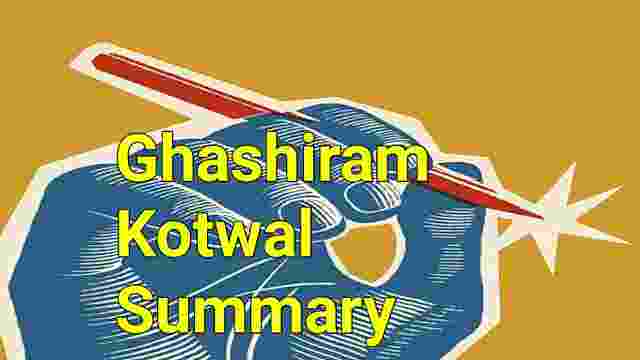Themes of play Ghashiram Kotwal
/ Tendulkar's Ghashiram Kotwal as a play that reflects some important issues of post-independence India. ---
Ghashiram Kotwal is set in eighteenth century Poona at the time of Peshwa rule. Ghashiram Kotwal indicates the particular social situation, which occurs in every era. It is a story about Ghashiram, a Brahman from North, who comes to eighteenth century Poona. It was time that the Peshwa's Chief Minister Nana Phadnavis rules supreme. In a false charge of theft, Ghashiram is insulted and humiliate by the Poona Brahman and he vows take to revenge. His time comes when the ageing lecherous Nana takes a fancy to his beautiful young daughter Lalita Gauri. He sacrifices his daughter's virtue to the Nana's lust and manages to become a Kotwal of Poona. Now he becomes a terror among the Brahmans the limit is crossed when he killed 22. This result in downfall of Ghashiram and his end was so miserable and he is stoned to death. The Nana who has used Ghashiram's daughter and disordered her when he moves on a fresh postures goes scout free. After Ghashiram's death, he announces public rejoicing for three days. So Tendulkar's Ghashiram Kotwal important issues of the post independence India are:
a play that reflects some Power: Tendulkar is concerned about the politics of power and its various implications. In Ghashiram, power is defined horizontally in terms of individuals against from victimisation. It also shows the power that Ghashiram himself a Brahman has turned against his other brethren. The opportunity for getting even with the Brahmans presents itself when the lecherous Chief Minister of Peshwa, the ageing Nana Phadnavi desires his beautiful daughter Lalita Gauri. Then begins the game of power in which Gauri is made a pawn and sacrificed to the Nana's lust. In return, he made the Kotwal of Poona. The power becomes of Ghashiram but it was not a power. Ghashiram who does not realise this and begins to mistake it for real power, he loses Lalita Gauri and his game is up, He is killed by crowd for killing 22 Brahmans. Thus, the power vested in Nana is also underpinned by social setup which functions on the basis of maintaining the status quo. Thus, there is whole hierarchy of power position. It seems then that it is an individual against an individual.
Religion:
The play-Ghashiram Kotwal begins with a religious hymn and the popular dancing on stage. This sets the context against which the drama unfolds itself. The Brahmans go to Bavanna Khani to see the dancing girl and say they are going to temple to give a sermon one "Vishvamitra and Menaka".
When Nana tries to seduce Gauri in front of the statue of the holy Ganpati, he simply dismisses her fears saying
"That the Holy Ganpati". Further, in the play when Gauri is dead and distraught Ghashiram confronts Nana and accuses him of his daughter's death, the letter reassures him that God is omnipresent. He makes everything, all merges into Ganga. So at that time Religion becomes a useful alibi in covering people's misdeeds. By invoking religion, all kind of evils are glossed and even sacrificed.
Caste:
Caste is also a major factor in this play. It is comment on the decadence of Brahmans. Caste is used as an instrument of power. Sutradhar reports that Ghashiram is a Brahman but he eats with lower caste and also sleep with the Mahar woman (a lower caste among the untouchables) is also considered a crime. On other hand, the Brahmans have no hesitation in chasing and pestering a white Sahib for money. This shows that race and colour constitute a higher position in social hierarchy. White Sahib ranks higher than the privileged Brahman who is feasted and showered with gifts in the Peshwa's Poona. Tendulkar has depicted the hypocrisy of the Brahmans. Brahmans wear holy thread but always involved in unholy activities. This play exposes the rottenness of the caste system that privileges a person on the basis of birth rather than merit and maintains the rigid hierarchy to control and suppress persons. Sexuality: Women too, as we have seen, have become a pawn in the power game. In fact, there is a close nexus between sexuality and the power. A man's self-image, identity and machismo is definable only, it seems in relation to the conquest and oppression of women. There is close connection between sexuality and religion. Gulabi's tantalising dances, the Nana's lustful pursuit of Lalita Gauri – the seventh woman in his life, the clandestine meeting of the Brahman wife with other Maratha lovers, all serve to create an underlying strain of eroticism throughout the play.
Violence:
Tendulkar explores many dimensions of the violence in India, He is not concerned about the violence of the state against the people but against the violence against other people. This is clear in Ghashiram's torture of innocent Brahman's and the belligerence of Gulabi's men against Ghashiram. In starting Ghashiram become a target of violence, he was badly beaten by Brahmans and after getting power, Ghashiram became violent. He killed so many Brahmans and finally this is violerice of mental cruelty - the manner in which Nana subdues Ghashiram's agony and anger at the death of his daughter by invoking protocol. So Tendulkar provides us with a blueprint for an unforgettable theatrical experience by sanitising the utter decadence of feudal society. By exposing the foibles and hypocrisies of Brahman's, he forces to think about the situation of our society.












0 Comments